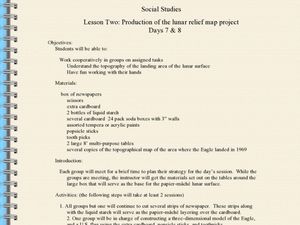Curated OER
Phases of the Moon
Here is a nice presentation on the ways to determine the phase, and the name of the phase of all the phases of the moon. For example, one slide shows the moon exactly half lit, with the light on the right hand side. This is the First...
Curated OER
Regolith Formation
Students explain the difference between regolith formation on Earth and the Moon. For this space science lesson, students model the different factors affecting regolith formation on Earth. They identify the different types of weathering.
Curated OER
Tour of the Solar System
Learners engage in science, math, and language activities as they do research on the components of the solar system. The class begins with some anticipatory activities and discussions before it is divided into small groups to conduct...
Curated OER
Lunar Cratering-Probability and Odds
In this lunar cratering worksheet, young scholars use probability to determine the outcome of coin flipping. They use this to represent the probability that asteroids will strike the moon in already cratered areas.
Curated OER
Getting an Angle on the Sun and Moon
In this Sun and Moon activity, students solve 6 problems about the angular scale of the images given, the size of the features on the images and the area of the features shown.
Curated OER
We Are Lunar tics!
Second graders, working in cooperative groups, will create a multimedia presentation about the Earth's moon. Their research must be presented through three or more methods. (i.e. charts; graphs; oral reports; multi-media; dramatic role...
Curated OER
Moon Watch
Learners can keep track of the phases of a moon with this lab sheet. They put the date, a sketch of the moon, and write down what phase it's in over the course of one complete phase of the moon. A great addition to an astronomy unit or a...
Curated OER
Why is There a Tidal Bulge Opposite the Moon?
Students simulate how the Moon causes ocean tides. In this earth science lesson, students calculate gravitational acceleration using a mathematical formula. They compare the force of attraction between the Earth, Moon and Sun system.
Curated OER
The Moon
Young scholars design and build an ideal lunar settlement. In this astronomy lesson, students identify the key features of the moon. They compare its environmental condition with the Earth's.
Curated OER
Impact Craters
Students investigate the factors affecting the size of a crater. In this space science lesson, students collect data from the activity and graph them. They explain how velocity of impact relate to crater size.
Curated OER
Working on the Moon
Students take a mission to the moon. In this space science lesson, students visit selected websites to discover information about Earth's moon and the solar system. Students may take virtual missions to the moon and share information...
Curated OER
Production of the Lunar Relief Map Project
Students replicate the lunar surface. In this mapping skills lesson, students study the topography of the moon. Students then use craft materials to create topographic maps of the lunar surface where the Eagle landed.
Curated OER
Moon Observation Sheet
In this moon observation worksheet, students observe the moon for a week, draw their observations, identify the phases of the moon, and indicate the time they observed the moon.
Curated OER
A Short Report on the Moon
In this moon report worksheet, students use the cover sheet and 3 lined pages to make a short mini-book about the moon. Students will do their own research and write the facts on the lines.
Curated OER
A Short Report on the Moon: Black and White Copy
In this moon report worksheet, students use the cover sheet and 3 small lined pages to make a short report on the moon. Students do their research, write on the pages and then cut it apart and staple to make a mini book. The cover may be...
















